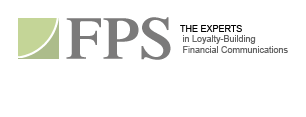 |
 |
| DECEMBER 2008 |  |
What we do |  |
Work Samples |  |
FPS Resource Library |
|
Spend less, get more: Battle recession with digital media by Vince DiPaolo If our current economic situation teaches one thing, it's that short-term thinking brings long-term, and sometimes devastating, consequences. The same holds true in marketing. Keeping that in mind, will bank marketers substantially change their strategies for 2009? Many should, experts say. "Bankers should focus on building trust and service quality," and shift their focus away from bolstering short-term earnings by increasing fees for financial services, says Rene Lisi, a CRM and customer experience consultant, in an article in the November 10 American Banker, "Scaling Back? Not on the Ad Budgets." Indeed, in an article in a recent edition of MarketScope, "The Cost of Lost Customers," and in a related white paper, The Cost of Customer Churn, we've shown, with hard numbers, the economic wisdom of engaging and retaining loyal customers for the long term. Today, more than ever, you need to reassure your clients of your long-term viability and commitment to be a steadfast financial partner. They're questioning not only your institution's stability, but examining their own long-term systems strength. One way to be proactive in addressing both of these issues is to publish a Special Report Q&A responding to questions on the minds of your corporate clients and easing their concerns. Send an e-mail request and we will send you a list of "Questions Corporate Financial Pros Are Asking Their Bankers." The consequences of short-term thinking The November article in American Banker draws some parallels between marketing presence and marketplace consequences. A case in point: "Citigroup third quarter advertising and marketing spend was down 33%, compared to the same time period last year, with this year's marketing focused on new customer acquisitions." While its reduction in marketing spend is only one of many factors contributing to Citigroup's current situation, it seems that lessening your market presence is not the most sound reaction in challenging times. In contrast, the American Banker article notes, banks that have increased their marketing budgets, such as PNC, KeyBank and Bank of America, have seen a notable return on that investment. But we've been mandated to decrease our marketing budget! While stepping up your client communications is arguably a wise move in these times, finding the funds to do so can be challenging. However, some marketers are finding that shifting to relevant, online marketing channels as opposed to traditional media allows them to do more with less. Through real-time tracking, electronic delivery offers actionable analysis, allowing you to stay relevant to client needs, down to the individual, and shortening sales cycles as you focus on the clients most likely to buy. This, in turn, leads to a lower cost per sale. (The Direct Marketing Association predicts that in 2008 commercial e-mail's ROI will be $45.65 for every $1 spent.) With the costs of paper, postage and ink on the rise, even an incremental shift toward electronic messaging vs. traditional print can reduce your marketing spend substantially, while conveying the positive undertone of "going green." Digital options engage B2B clients One industry survey shows that while clients are looking to engage with solutions-based content delivered through cost-effective digital media, marketers consistently fall behind in providing it. In its October 2007 white paper, The Digital Transformation, Forrester Research surveyed 878 B2B decision makers about digital media's impact on their decision-making process. Here are some highlights:
The effectiveness of digital media According to the 2008 Email Marketing Metrics Report, a survey of 13 industry sectors conducted January through June 2008 by e-mail services provider MailerMailer, e-mails from banking/financial services providers enjoyed the highest open rates — 29% — up from 28% in 2007. These same e-mails recorded click-through rates of 6.98%, ranking second only to the real estate industry (7.01%) in the same survey. Web video is another delivery channel enjoying success among marketers. Web video "provides a monumental opportunity — and challenge — for digital marketers," says Geoff Ramsey, CEO of eMarketer. He says the challenge is to harness online video as an advertising and marketing platform. While the list is long for digital marketing options, e-mail and video remain top choices for B2B marketers looking to achieve an optimal ROI. . . . Financial Publishing Services Co. If you are not already a MarketScope subscriber, please request your own free monthly edition. |